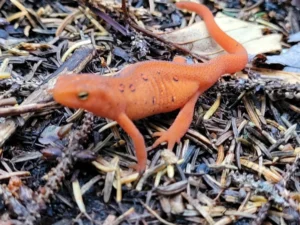Salamanders are small animals that can be easy to miss in the wild. They look like lizards, but they are not. Their skin is soft and moist, and many spend time both in water and on land. You might wonder: are salamanders predators, or are they the ones being hunted?
Salamanders can be both predator’s and prey, depending on their size, species, and environment. Some salamanders eat insects, worms, and small animals. But many larger animals eat salamanders too.
Their role in nature changes depending on where they live.
A small salamander in a forest might hide from birds, snakes, or raccoons. A larger salamander in a pond may catch small fish, insects, or tadpoles.
How Salamanders Hunt: The Predator Side
Salamanders might be small, but they are skilled hunters. Many have long, sticky tongues that shoot out to catch insects quickly.
They are mostly active at night, which makes it easier to sneak up on prey without being seen.

Even though they look delicate, salamanders can move fast when needed. Some catch insects, spiders, and small crustaceans.
Larger species eat tiny frogs, small fish, and even other salamanders. They rely on their senses to find food. Salamanders can feel vibrations in the ground or water, helping them locate prey even in the dark.
Some salamanders hunt differently depending on their habitat.
Aquatic salamanders may lie in wait underwater. Terrestrial salamanders may roam slowly, searching under leaves, logs, and rocks. Hunting can be patient or active, depending on the prey.
Even as predators, salamanders are careful. Their soft skin makes them vulnerable to drying out, so they often hunt near water or damp areas.
They also stay alert for animals that want to eat them. Hunting is a balance between finding food and staying safe.
The Prey Side: Who Eats Salamanders?
While salamanders can hunt, they are also food for many animals. Birds, snakes, raccoons, fish, and even other salamanders will eat them if they can catch them. Salamanders are often small and slow, so hiding is their best defense.
Some salamanders have bright colors to warn predators they are poisonous. These warning colors keep some animals away.

Others use camouflage to blend into leaves, mud, or rocks. Even with defenses, many salamanders fall prey to faster or smarter animals.
Humans can be a danger too. Salamanders are sometimes collected for pets or harmed by habitat destruction. Their role as prey is part of nature’s balance.
Without predators, salamander populations could grow too large and upset the environment.
Size Matters: How Being Small or Large Changes Their Role
Not all salamanders are equal in the food chain. Smaller species are more likely to be prey. Larger species can be effective predators.
For example, a small red-backed salamander mostly hides and eats tiny insects.

A larger tiger salamander may eat small frogs and fish while still avoiding birds or raccoons.

As salamanders grow, their diet changes. Young salamanders eat tiny insects and worms. Adults eat bigger prey. Predators change too.
Juveniles are easy targets for almost any predator, while adults are mainly at risk from larger animals.
Size also affects how salamanders hide and move. Larger salamanders can burrow deeper, swim faster, or use bright colors to warn predators.
Small ones stay hidden under leaves, logs, or moss.
The Role of Salamanders in the Ecosystem
Salamanders are a bridge in the food chain. They control insect populations and provide food for larger animals.
Without salamanders, some insects might overpopulate, and animals that rely on salamanders for food could struggle. They also recycle nutrients by breaking down prey and returning nutrients to soil.
In forests, salamanders are very important. They live under logs, rocks, and leaf litter.
As predators, they eat insects that could harm plants or spread disease.
As prey, they feed animals that might otherwise turn to other, less balanced options.
Conclusion
Salamanders are fascinating animals that are both predators and prey. They hunt insects, worms, and small animals, helping control populations in their environment.
At the same time, they are food for birds, snakes, fish, and mammals. Their size, species, habitat, and season all affect whether they are more predator or prey at any moment.
Even though they are small, salamanders play a big role in nature. They help keep ecosystems balanced by controlling insects, providing food for larger animals, and recycling nutrients in soil.
By understanding salamanders, we see how every animal, no matter how tiny, is important in the web of life.
Next time you spot a salamander under a log or near a pond, remember: it might be quietly hunting, but it’s also always watching out for predators.
Hi, my name is Ezra Mushala, i have been interested animals all my life. I am the main author and editor here at snakeinformer.com.

